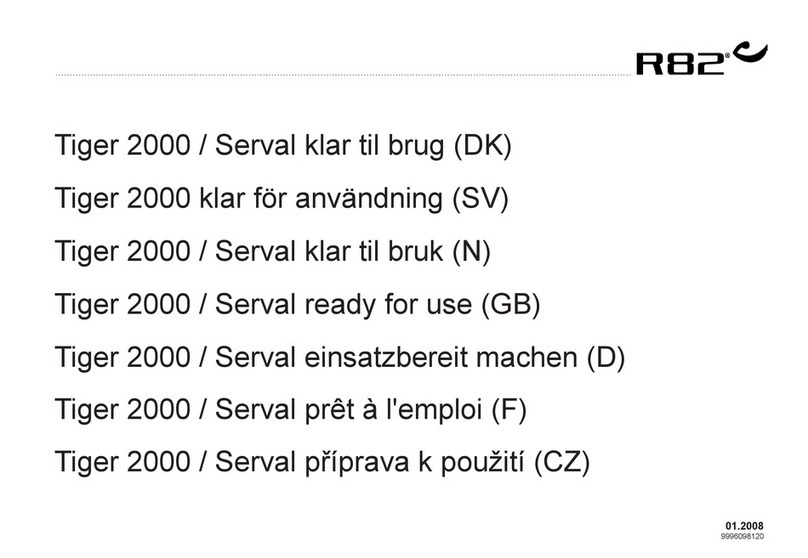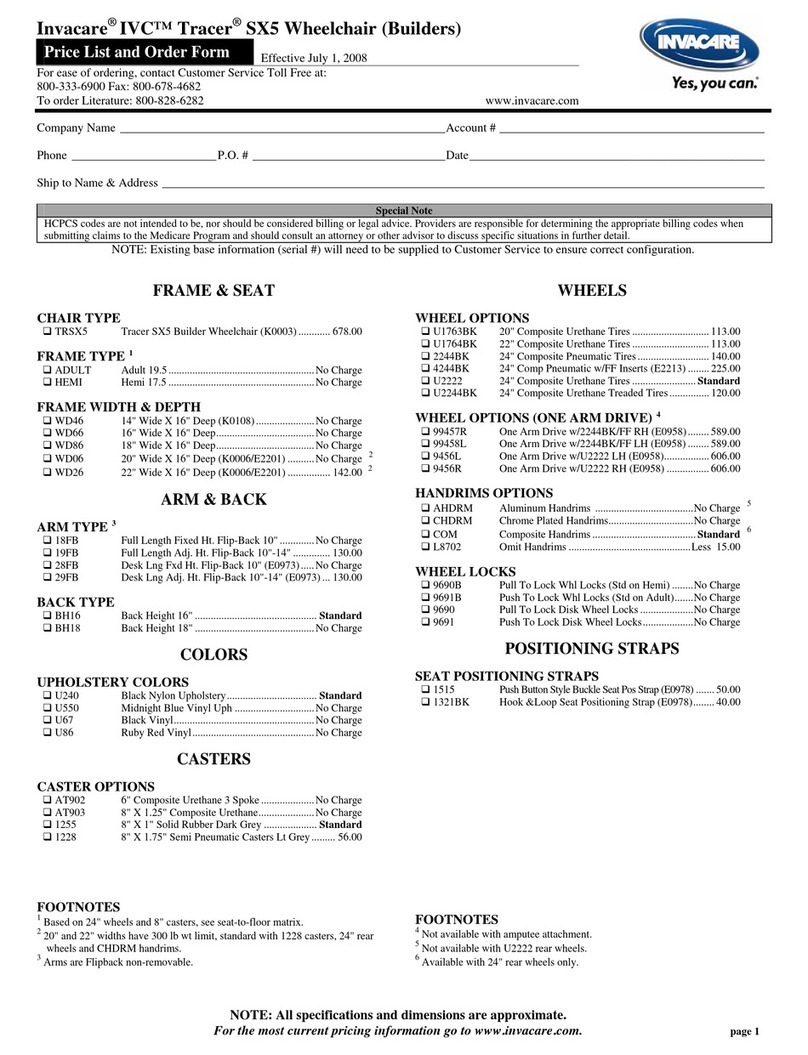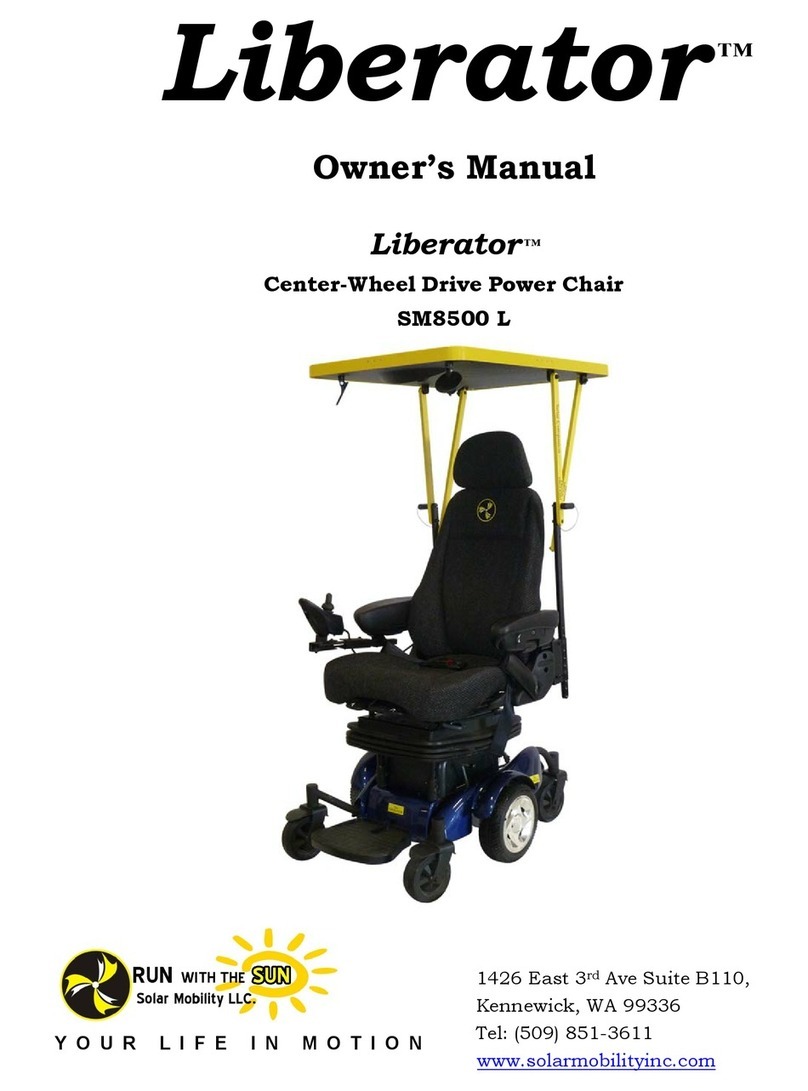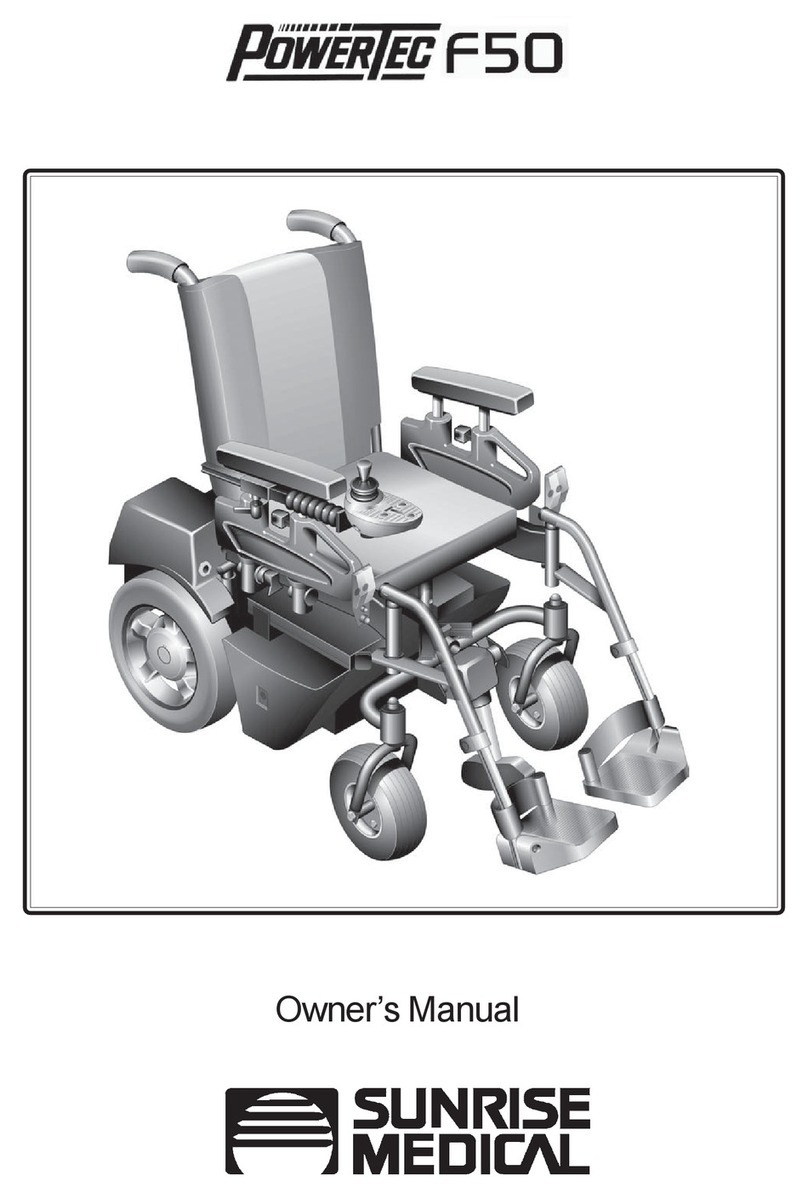FHM Joy-Rider User manual

Joy-Rider
User Manual of Portable Electric Wheelchair
!
Z2A01C87AAB

Table of Contents
1. Introduction 3......................................................................................................................
2. Guidance for using 4...........................................................................................................
3. Safety sign of products 5....................................................................................................
4. Technical specification 6.....................................................................................................
5. Features 7...........................................................................................................................
5.1. Feature-1 7
5.2. Feature-2 8
6. Electromagnetic interference warning 9.............................................................................
7. Safety 10.............................................................................................................................
7.1. Joystick Controller 10................................................................................................
7.2. Static state 11
7.3. Weather defence measures 11.................................................................................
7.4. Pavement 12
7.5. Vehicle transport 12..................................................................................................
7.6. Weight distribution 13................................................................................................
7.7. Getting on and getting off wheelchair 13...................................................................
7.8. Obstacles 14
7.9. Ramps 14
7.10. Reverse driving 14..................................................................................................
7.11.Use on Stairs and Escalators 15..............................................................................
8. Operation guidance 16.......................................................................................................
8.1. Control panel 16........................................................................................................
8.2. The following table shows various states of the battery power display 17................
8.3. Joystick operation 18................................................................................................
9. Operating guidance 18.......................................................................................................
10.Brake 19.............................................................................................................................
10.1.Electromagnetic brake lever 19................................................................................
10.2.Electromagnetic brake system 19............................................................................
11.Battery 20...........................................................................................................................
11.1.Battery maintenance 21............................................................................................
11.2.Install/remove the battery 22....................................................................................
11.3.Install the battery 22.................................................................................................
11.4.Charge 23
1

11.5.Over-discharge protector 24.....................................................................................
11.6.Over-current protector 24.........................................................................................
12.Unfolding and folding 25.....................................................................................................
12.1.Unfolding 26
12.2.Folding 27
13.Troubleshooting 28.............................................................................................................
14.Packing list 30....................................................................................................................
15.Warranty sheet 30..............................................................................................................
15.1.Exceptive clauses of warranty 31.............................................................................
15.2.Disclaimer 31
"2

1. Introduction
Thank you for choosing the Joy-Rider, it will become your partner to help you travel
comfortably and increase your independence.
As folding the Joy-Rider only takes a few seconds, it can be stored in a small area taking
up less space indoors and allows the chair to be easily placed in a vehicle, taxi, or used on
public transport. Using Joy-Rider frees you to travel to many more places and at a time
your choose!
Your safety is of the highest importance. Before using the electric wheelchair for the first
time, please carefully read and follow all instructions in the manual. For your safety, it is
very crucial to fully understand all instructions in the manual.
For any loss of property or personal injury caused by improper use of wheelchair or
incompliance with the instruction, the manufacturer and distributor assumes no legal
responsibility.
If you have difficulty in understanding the warnings and instructions in this manual, please
get touch with the dealer or supplier. Our intent is to widen your horizons and enrich your
life!
"3

2. Guidance for using
Before using the product for the first time, the user must completely read and understand
the manual.
If you are unable to understand the warnings, tips and instructions in this manual or in
need of extra help, please contact the authorized supplier or distributor, in order to receive
professional guidance and help. If you do not follow this manual, it will lead to security risk
due to incorrect use, and void the warranty.
Reference data
Authorized supplier:
Address:
Phone number:
Date of purchasing:
"4

3. Safety sign of products
The following symbols are used to identify the warnings, mandatory measures and
prohibited actions. Before using Joy-Rider for the first time, comprehensive understanding
and being thoroughly familiar with these signs are of great importance.
Read and follow the instructions in this manual.
Safety warning signs or instruction of dangerous operation endangering
the safety of users or others.
When operate a wheelchair, do not use the mobile phone, walkie talkie,
electronic equipment or other radio transmitters.
Mind your hand - potential pinch point.
Keep it in a clean and dry condition; keep away from rain, snow, ice, salt
and water.
The battery contains corrosive substances
Risk of explosion
The tools and other metal items must be kept away from the battery
connector. Once connected, it may cause a short circuit or electric shock
and damage.
Flammable substances, avoid contact with open flame or spark source.
Avoid that the battery and inflammable goods are transported together.
Processing and recycling
!
!
!
!
!
!
!
!
!
!
"5

4. Technical specification
Specification
Size (unfolded):
length*width*height
855×645×910mm
(folded): length*width*height
1115×645×320mm
Suggested weight of user
Maximum load: 253lb (115kg)
Gross/net weight
Weight with battery of 21.6kg/weight without battery of 20kg
Maximum climbing angle
12°(depending on the weight of the user/climbing safe angle)
Full charge mileage
13km (varies with the user's weight, terrain, ground environment, battery
status and driving habits)
Maximum speed
6km/h
Maximum turning radius
900mm
Motor
Type
DC brushless motor
Motor power
200W x 2
Input voltage
DC24V
Quantity
2 motors
Brake system
Electromagnetic brake
Braking distance
Within 90cm
Battery
Type
Lithium battery
Rated capacity
8.7Ah
Output voltage
DC24V
Controller
Type
Brushless double drive joystick controller
Front wheel
Size
7 inches
Type
PU solid tyre
Number
2
Rear wheel
Size
10 inches
Type
Pneumatic tyre (including inner and outer tyre) 20~28PSI
Number
2
"6

5. Features
5.1. Feature-1
!
1.Backrest handrail
2.Backrest
3.Armrest
4.Joystick
5.Front leg
6.Seat
7.Footrest
8.Front wheel
9.Rear wheel
"7

5.2. Feature-2
!
10. Folding release cable
11. Anti-tilting wheel
12. Electromagnetic brake lever
13. Control Box
14. Battery
15. Motor
"8

6. Electromagnetic interference warning
The electric wheelchair may be affected by the electromagnetic interference (EMI), which
can cause damage or interference to wheelchair. For the user, it is important to understand
how this can happen and take protective measures against the risk of interference.
The electromagnetic wave sources from radio & TV stations, radio transmitters, two-way
radio equipment (such as walkie talkie), mobile phone and computer. The interference by
electromagnetic waves may cause malfunction or permanent damage to the wheelchair
brake system and control system.
1. The users should pay attention to the following safety guidelines:
●Please do not turn on or use the portable transceiver, radio, radio broadcasting
or any wireless communication equipment.
●Keep away from all radio sources.
2. If the wheelchair shows uncontrollable or unintentional movement, please
disconnect the power supply immediately.
3. It is not allowed to modify the electric wheelchair in any way, including any addition
or substitution of any parts.
Warning
!
"9

7. Safety
●Check all power supplies and mechanical connections to ensure their safety and
firmness.
●Check the battery at least once per month to ensure that the battery can be
charged.
●Keep all metal objects away from the battery's positive and negative poles,
otherwise, when sudden connection of two poles occurs, it will lead to short-
circuit or electric shock.
●Familiarise yourself with all functions of the Joy-Rider.
●When you use it for the first time, please carefully check the user manual until you
are completely skilled in the use of the wheelchair.
●When using the electric wheelchair, the user should always pay attention to the
potential danger around them.
●When the electric wheelchair is not in use, please cut off the power supply, charge
the battery and store it in a clean and dry place.
7.1. Joystick Controller
When using the electric wheelchair, in order to ensure your personal safety, the joystick
controller must be installed safely (as shown in Figure A1). If any switch on the control
panel fails to work or has no response, please immediately stop using the wheelchair, and
contact the manufacturer for repair or replacement.
Safety guidance
!
A1
!
"10

7.2. Static state
When the wheelchair is not in use, the power must be switched off even for a short period
of time (see Figure A2). This will:
●prevent accidental contact with the joystick, resulting in unexpected movement of
the wheelchair.
●Prevent the wheelchair from being unintentionally operated by any electromagnetic
interference.
Please don't allow anyone other than you to touch the joystick controller. This will prevent
potential personal injuries if the wheelchair is moved unintentionally.
7.3. Weather defence measures
!
It is prohibited to use and store electric wheelchair in the rain, snow, icy or wet
environment. These weather conditions can seriously affect the function of the wheelchair.
Please keep the wheelchair in a clean, dry place.
If the equipment contacts the rain, snow, or in a high-humidity environment, there may be
a fault. Please avoid the wheelchair being exposed to extremely heat or cold
environments. Joy-Rider is not a fully waterproof wheelchair. High-humidity environments
can lead to dust or corrosion inside the wheelchair. If you are in any one of the above
environment, please immediately cover the wheelchair to prevent damage.
In order to avoid equipment failure, please follow the guidelines below:
●Please avoid using or storing of the wheelchair in the following circumstances:
direct contact with water; extremely high or low temperature; high humidity
A2
!
"11

environment.
●Please do not use this electric wheelchair in the shower or swimming.
●Please do not use this electric wheelchair in brine or clear water.
●Please do not flush the wheelchair with water.
Note: when the wheelchair is in a wet state, please immediately remove the battery, and
make it dry naturally. After the wheelchair is completely dry, reinstall the batteries.
When using a wheelchair on wet or slippery ground, please move it carefully and observe
the following safety guidelines:
●If any wheel loses traction, you must immediately stop the wheelchair to prevent
loss of control (e.g., slide, overturned, etc.).
●Please do not use the wheelchair on a slope when the surface has ice, snow,
water and oil.
7.4. Pavement
Joy-Rider is designed ideally for dry ground such as a hard floor or indoor floor.
Please don't use Joy-Rider on sand, uneven or loose ground, high grass or rough
pavement, so as to prevent damage to wheels, bearings, motors and other parts.
Do not use the wheelchair on a public road with traffic. If using the wheelchair to cross
public roads, the user must observe local traffic rules and take great care for your own
safety. It is strongly recommend that you wear reflective clothing when using a wheelchair
at night.
7.5. Vehicle transport
!Please note: the user takes all responsibility if using Joy-Rider with any other forms
of transport (such as: car, bus, train, ship or plane).
If you must use a wheelchair with other forms of transport, the following operations are
very important:
• turn off the power supply and push the brake levers to the "locked" position. Check that
the wheelchair is locked and cannot freewheel. This will help avoid any damage caused
by sudden braking. However, you can easily fold this electric wheelchair and place it in
the appropriate storage space, such as the trunk. Please make sure that the wheelchair
is safely placed to avoid injury.
!Please don’t allow anyone to lift the wheelchair onto any other mode of transport if
you are sitting in the chair, otherwise the user will bear the consequences.
"12

7.6. Weight distribution
In order to avoid overturning when driving the wheelchair, the balance and stability of
electric wheelchair cannot be ignored. The following factors will affect the weight
distribution of wheelchair:
●Height and angle of seat.
●The sitting position or weight-bearing position of user.
●Tilting slope
●The user's weight will affect the weight distribution of the wheelchair.
!Please do not make self-modification or adjustment of the structure of Joy-Rider.
7.7. Getting on and getting off wheelchair
It is recommended for you to take the armrests as supporting points and NOT the joystick
when you move into or out of the wheelchair. Excessive pressure on the joystick can
cause it to be damaged. Please note the following points in order to reduce the likelihood
of falling:
●Before getting on or off the wheelchair, make sure the power supply is off and the
brake levers are in the locked position. Check that the wheels make no
movement.
●Position the wheelchair closest to the target position to minimize the risk of falling
in the process of leaving the wheelchair.
●Consult your health care provider for the method of getting on and getting off the
wheelchair.
●Please do not stand on the footrest while getting on or off the wheelchair.
●Position your feet in front of the footrest to avoid getting them trapped.
●When you sit in the wheelchair, do not lean outside of the wheelchair as it can
seriously affect the balance of the wheelchair and may result in the wheelchair
turning over.
●Please don't take heavy objects when sitting in the chair as this can cause in
imbalance.
●Please do not move your weight excessively toward the upper part of the backrest
to prevent overturning of wheelchair or damage to the back.
"13

!Violation of the above guidelines may cause serious injury. If any of the above
actions are ignored, the consequences will be at the user's own risk.
7.8. Obstacles
Particular care should be taken when using the wheelchair on a slope, near to the edge of
a road, on a bumpy or rough road. Please be extremely careful to avoid the wheelchair
overturning.
!Do not exceed the limit in the inclination guideline and instructions in the manual.
Notes when encountering obstacles:
●Please drive slowly when getting close to obstacles, and keep straight.
●Please be extremely careful to speed up slowly when the front wheels reaches the
obstacle After the rear wheel passes over the obstacle, slowly accelerate to move
forward.
●Please keep the upper body upright when going uphill, and slightly lean forward.
●Please keep the upper body upright when going downhill, and slightly lean
backwards.
●Please don't suddenly start or stop.
7.9. Ramps
If the user has difficulty when driving uphill, please seek help from others to protect you
from harm.
●It is suggested not to drive the wheelchair on slopes of over 10 degrees, and it is
not allowed to drive the wheelchair on a slope greater than 12 degrees.
●Please don't turn when you are on a slope.
●Avoid driving the wheelchair on a wet, smooth slope (such as snow, rain, water,
oil).
●Don't drive the wheelchair on an uneven slope.
●Don't drive the wheelchair on a continuous uphill and downhill path.
7.10. Reverse driving
!Take great care when driving the wheelchair backwards. When the motor touches an
obstacle, it may cause the wheelchair to lose control or turn over.
"14

●Don't drive the wheelchair backward on a slope.
Load limit
●Maximum load on seat: 253 pounds (115 kg).
●Never overload the wheelchair.
●Safety weight of seat back : 165 pounds (74.8 kg)
●Do not press down or lift seat back.
●The user is not allowed to sit on the seat to perform weight training.
●Overloading will lead to damage to the seat frame, fixing parts and folding device.
●Damage caused by overloading is not within the scope of the warranty.
7.11.Use on Stairs and Escalators
Joy-Rider is not designed for use on stairs and escalators.
!It is prohibited to move and use Joy-Rider on stairs and escalators, otherwise it will
seriously damage the seat body."
"15

8. Operation guidance
8.1. Control panel
The control panel consists of the following components:
1
Power button
Press this button to start the
power supply, press again to
turn off the power supply.
2
Increase max
speed button
Increases the speed of the
wheelchair.
Maximum speed: 6km/h
3
Decrease max
speed button
Reduces the speed of the
wheelchair.
Minimum speed: 2km/h
4
Horn
Press the horn to sound horn.
5
Battery power
display
Indicates the remaining battery
power.
6
Joystick
Control the direction and speed
of the wheelchair.
7
Speed display
When 10 LED lamps are
illuminated, the wheelchair is at
the maximum speed setting.
When 2 LED lamps are
illuminated, the wheelchair is at
the minimum speed setting.
!
"16

8.2. The following table shows various states of the battery power
display
※Immobilisation Feature
After switching on the power supply, press and hold the power button for 4~5 seconds to
enable the immobilisation feature. This makes the joystick inoperable.
To turn off this feature, press the + acceleration button for 3 times within 10 seconds to
unlock.
Illumination display
Description
Reason
Remarks
No LED’s on
Power supply is
switched off or in
standby state, or the
system has entered
sleep mode.
All LED lights on
The power supply is
on and battery is fully
charged
As the battery is used,
the number of LED's
illuminated will reduce
towards Red.
Red LED light on
the left side flashes
Battery capacity is
not sufficient.
Please charge the
battery as soon as
possible.
LED’s illuminate
once from left to
right in order
The Brake Levers
are in the Freewheel
position
Move the brake levers
to the locked position
to operate the chair
under power
Only one light
repeatedly cycles
from right to left.
The wheelchair has
been immobilised※
and is waiting for
unlocking.
Press the +
acceleration button for
3 times within 10
seconds to unlock.
The LED's are
repeatedly blinking
from left to right in
order.
The battery charger
is connected to the
wheelchair and is
charging.
The joystick cannot be
operated when the
battery is being
charged.
!
!
!
!
!
!
"17

8.3. Joystick operation
When operating the wheelchair for the first time, start it slowly and gradually push the
joystick forward. This will help you become familiar with controlling the speed and direction
of the wheelchair.
Do not turn the wheelchair suddenly at high speed, otherwise the wheelchair may lose
balance and overturn, potentially causing personal injury.
The joystick operates in a full 360-degree. It is is equipped with a spring which allows the
joystick to automatically return to the original place when released.
The degree movement is proportional to speed. A small movement of the joystick will make
the wheelchair move slowly. A larger movement will increase the wheelchair’s speed to a
maximum of 6km/h. Gradually reducing the joystick’s movement will smoothly bring the
wheelchair to rest. Sudden movements of the joystick may cause loss of balance and
overturning, resulting in personal injury.
9. Operating guidance
Move
Control the operating lever
Move
forward
Push the control lever forward
Move
backward
Pull the control lever backward
Move
rightward
Push the control lever to the right
Move
leftward
Push the control lever to the left
Stop
Release the control lever gradually
(decelerate the wheelchair and stop it safely)
!
"18

10.Brake
!After any adjustment, repair and maintenance of the wheelchair, check all the
assembly and fastening parts before using, or it may cause damage and harm.
10.1.Electromagnetic brake lever
10.2.Electromagnetic brake system
The brake lever is used to "lock" and "unlocked" the wheelchair which has two operating
modes:
●The "locked" state. The clutch in the electromagnetic brake is closed resulting in
the drive wheels being locked. With the levers in this position, the wheelchair is
operated under power and controlled with the joystick.
●The "unlocked" state. The clutch in the electromagnetic brake is not closed
resulting in the drive wheels being unlocked. With the levers in this position, the
wheelchair is able to freewheel allowing it to be moved manually and not by the
joystick.
!Attention
Before using the wheelchair, the brake lever must be in the "locked" state, and the
electromagnetic brake is used to prevent the rear wheels from rotating. This will prevent
accidents and personal injury.
Without a Carer being present and in full manual control of the wheelchair, don’t use or sit
on the wheelchair when the brake lever is in the "unlocked" state. It will freewheel and the
brakes will not be applied. This is particular dangerous on a slope and can result in
personal injury and damage to the wheelchair.
Lock
Unlock
!
!
"19
Table of contents
Popular Wheelchair manuals by other brands
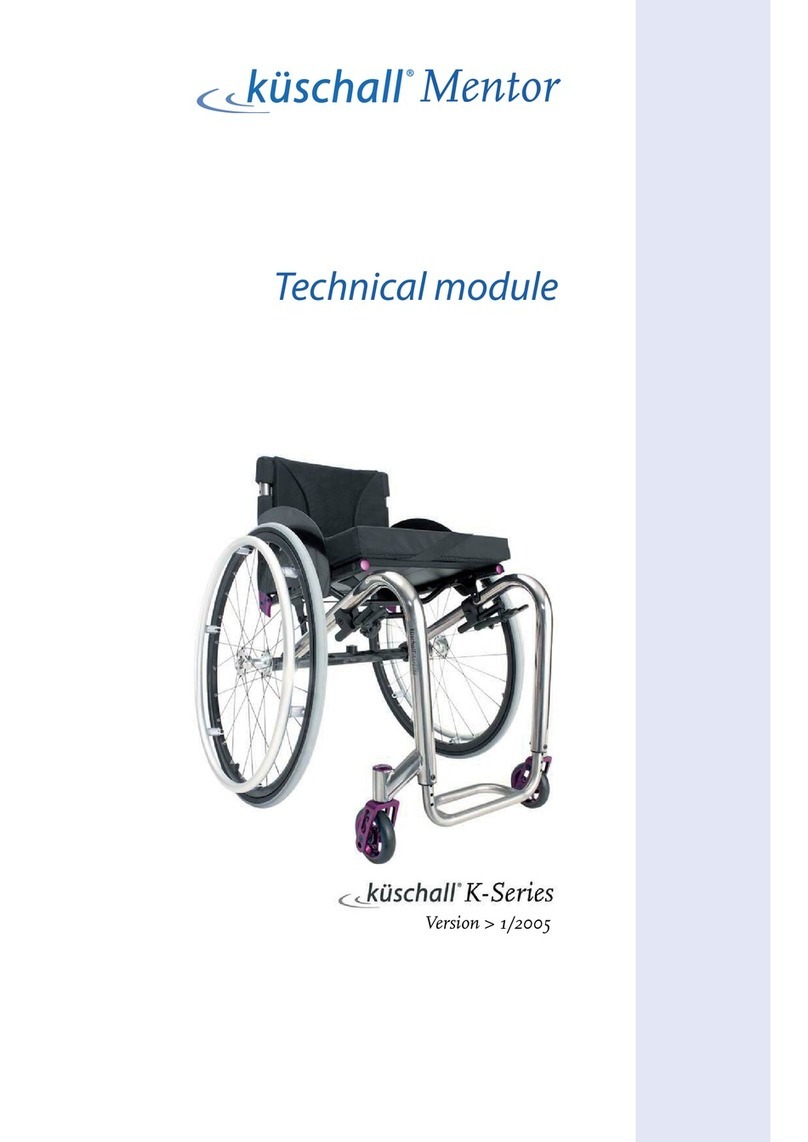
Kushall
Kushall K-Series user manual
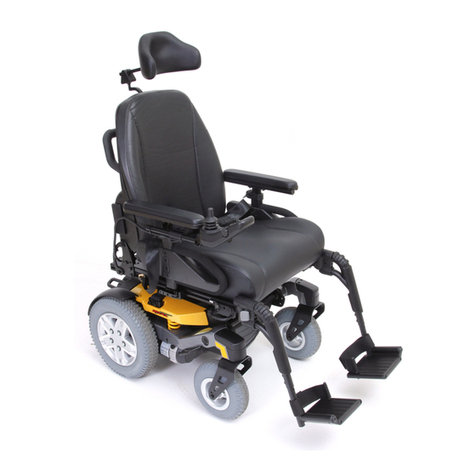
Pride
Pride Quantum Rival series owner's manual

Qantum
Qantum 1107 owner's manual
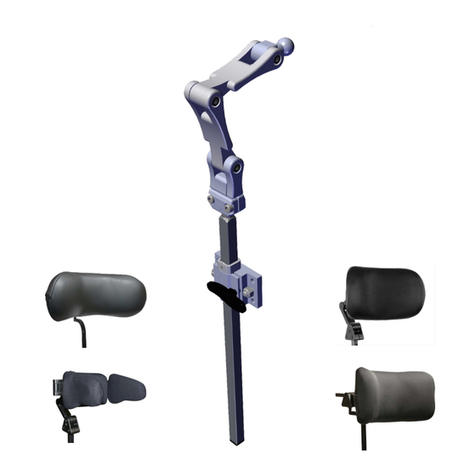
Stealth Products
Stealth Products UniLink Comfort Plus Series Owner’s Manual and Maintenance Guide

Comfort Company
Comfort Company ACTA-CONTOUR quick start guide
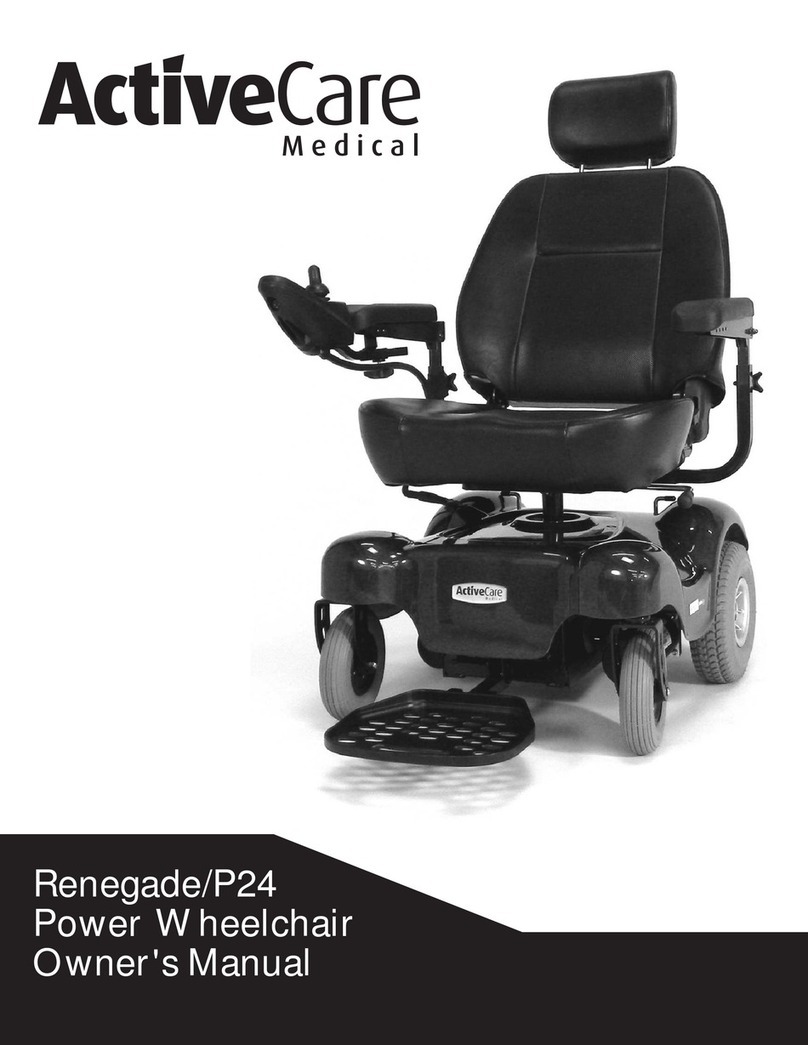
Active Care Medical
Active Care Medical Renegade/P24 owner's manual
